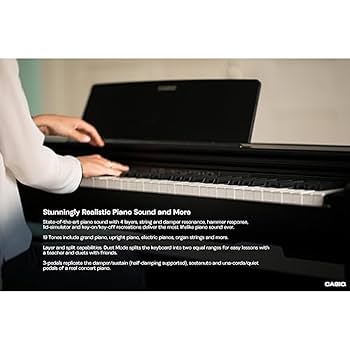Casio Privia PX-870 Digital Piano

The other day, I was in a furniture store, pretending to browse (as one does). I heard a familiar melody, a surprisingly rich tone spilling from… a digital piano tucked discreetly near the lighting section. My fingers, they simply itched.
It was the Casio Privia PX-870. Now, I’ve played my fair share of digital pianos, seen the evolution from tinny, lifeless keyboards to these surprisingly sophisticated, home-friendly models. The PX-870 is more than just a box of plastic and wires; it’s a legitimate instrument, designed with both the aspiring beginner and the experienced player in mind. The Tri-Sensor II Scaled Hammer Action keys provide a realistic feel. That responsiveness? Crucial for building proper technique. I mean, how many times have I seen students struggle to translate their digital practice to a proper acoustic? The PX-870 minimizes that hurdle.
My first impressions? The sound. It genuinely impressed me. The 40W 4-speaker sound system delivers a surprisingly full and nuanced experience, particularly given its price point. I mean, you can get a decent acoustic piano for the same money, but then you’re dealing with tuning, space constraints, and your neighbor’s complaints. Digital pianos like this one offer a clear convenience edge. The way the “acoustic simulator” responds to velocity and resonance? It’s quite clever, mimicking the complex soundboard interactions of a real piano. And the included hall and reverb simulations really create an immersive experience, even in less-than-ideal acoustics.
The elegant design, with its console-style cabinet, hides all the technical wizardry within. This is a piano designed to look like a piano.
Now, no instrument is perfect. The built-in metronome could be more flexible in terms of subdivisions. It’s certainly functional, but for complex time signatures, it can feel a bit… basic. I’d advise a separate metronome app for practice in more intricate rhythms. However, let’s be honest: that’s a tiny quibble.
Compared to the older PX-860, the 870’s updated sound engine and key action represent a noticeable step up, offering a more refined and realistic playing experience. If you are on the fence between the two, I highly recommend the newer model.
So, who’s this piano for? I’d say it’s perfect for the serious beginner or the intermediate player who craves a realistic, affordable, and space-conscious instrument. This is an excellent starting point. Go ahead, take the plunge and buy it, but practice!